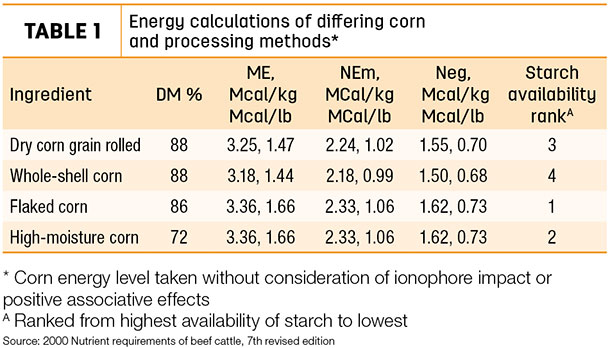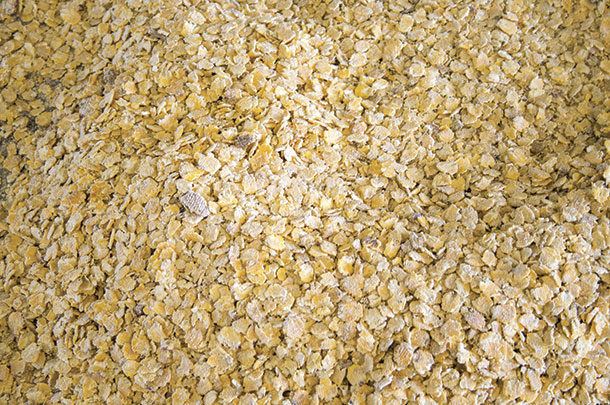Two things we understand well is that unit cost of production and feed inventory continue to impact ration formulation. Here in the Midwest, environment has seemingly dictated feedstuff harvest and selection and usage rate the past few years as well.
It’s hard to pick one corn processing source and moisture level and say it’s the best one out there, as other ration ingredients heavily impact how well that product is metabolized. Cost per unit of nutrient – with corn this would be energy – also dictate level of usage in the total ration in comparison to other energy type feedstuffs.
Trying to keep things simple, looking at the amount of energy, cost per pound or per bushel (on a dry matter basis) once processed weighs heavily on how much of that product is utilized in a ration, alongside production goals. Positive associative effects with available ration ingredients also impact animal performance, which can’t necessarily be calculated when just looking at unit cost of production of corn alone.
In the Midwest, most corn is fed as dry rolled corn (DRC) with variation in grind, high-moisture corn (HMC) with variation in moisture content or whole-shell corn (WSC). While in the Southern Plains, most feedlots utilize steam-flaked corn (SF) and HMC.
Corn processing is utilized to increase the amount of starch (energy) available to the rumen microbes and can enhance bunk management by improving feedstuff mixability through the total mixed ration (TMR). Efficient corn utilization itself can vary by how well-processed the grain is, level of moisture and flaking density of the grain, and how this corresponds with both total tract starch digestibility and ruminal pH.
If you look at energy composition of the most commonly fed processed corn types, taken from the 2000 edition of Nutrient Requirements of Beef Cattle, seventh revised edition (see Table 1), you can see how energy differs between the standard processed methods in relation to their ingredient dry matter (DM).

Let’s look at some of the considerations of the most commonly fed corn types listed above:
Dry rolled corn (DRC):
- Typically, the least expensive processing method
- Utilized more in the Northern region where corn price is not as expensive
- Feeds well with Midwest rations, which include wetter byproducts and higher-moisture forages such as earlage and silage
- Rolling opens the kernel up for more ruminal starch availability without overprocessing
- Lowered chance of reducing dry matter intake (DMI) due to large ruminal pH changes which can occur with heavily processed grains
Whole-shell corn, dry (WSC):
- Fed mostly in long day fed cattle or cattle with little to no fiber available
- Fed in self-feeder type rations acting as both a starch and scratch factor to the rumen
- May allow for more starch to reach the small intestinal tract
- Least expensive to harvest and store
- Typically, fewer negative associative effects due to greater rumen stability
Steam-flaked corn (SF):
- Most expensive and timely to process
- More equipment needed to harvest and store
- Allows for extensive ruminal starch availability with the highest amount of energy available per unit of measurement
- Typically fed around 20% moisture
- Higher instance of reduced DMI due to high starch available, lowering ruminal pH
- Bunks managed correctly may see greatest average daily gain (ADG) and lowest feed-to-grain ratio, even with the lowered DMI
- Medium density flakes (23 to 29 pounds per bushel) tend to give the best performance over thin (less than 22 pounds per bushel) and intermediate to thicker flakes (greater than 29 pounds per bushel) when looking at feed conversion
- Performance impacted by forage level inclusion in the diet
High-moisture corn (HMC):
- Moisture level must be managed to reduce spoilage
- A study indicates gain and energy are maximized when HMC is fed at 30% to 31% moisture
- More equipment needed to harvest and store properly
- Most recommend rolling instead of grinding product but must ensure it is processed enough to get a tight packing density pending storage type
- Has less negative effect on DMI
- More energy available per unit of measurement
- Adds moisture to the diet which can help reduce sorting
- Requires better bunk management due to higher rates of fermentation
It is also important to talk about harvesting corn in the appropriate moisture content and storing these products correctly to ensure that digestibility is maximized without compromising feed stability. Feed stability for high-moisture type products is key to reduce yeast, mold and mycotoxin growth.
Even when harvesting corn at the opportune moisture level, if you fail to put it up with oxygen limiters or ensuring adequate packing density, you will have negated energy density of the product due to unstable fermentation and mold and yeast growth.
You will also compromise cattle immunity when feeding these unwanted side effects of poorly processed, poorly packed and/or stored or not inoculated products. Storage considerations are crucial to keeping oxygen out of the product for the longevity of its feedout phase.
The extent of corn processing and its moisture level can also interact with roughage type, level of roughage fed and roughage forage moisture. When reviewing corn processing type and forage moisture levels, a study showed that differences in ADG become apparent as well as improvements or reductions in corn energy level pending type of forage, forage moisture level and inclusion. It is important to understand the correlations between these when formulating diets.
It should go without saying, after reviewing the intricacies which are involved in utilizing the right corn type for your operation, one must work with a skilled nutritionist when formulating rations for optimal performance and lowest cost of gain (COG). Variability among managers, ration consistency, moisture content and cost of production must all be taken into consideration.
When grain is processed more extensively, more labor, cost, equipment, energy and skill is required. Additionally, feedbunk management must be tightly regulated to aid in control of metabolic disorders. ![]()
PHOTO: One must work with a skilled nutritionist when formulating rations for optimal performance and lowest cost of gain. Staff photo.
References omitted but are available upon request. Click here to email an editor.

-
Heidi Doering-Resch
- Beef Technical Specialist
- Form-A-Feed Inc.
- Email Heidi Doering-Resch









